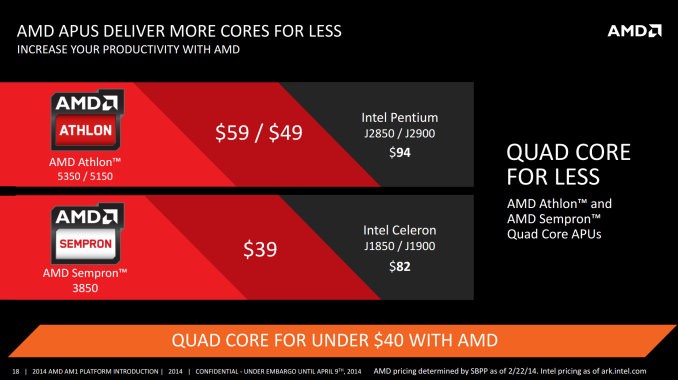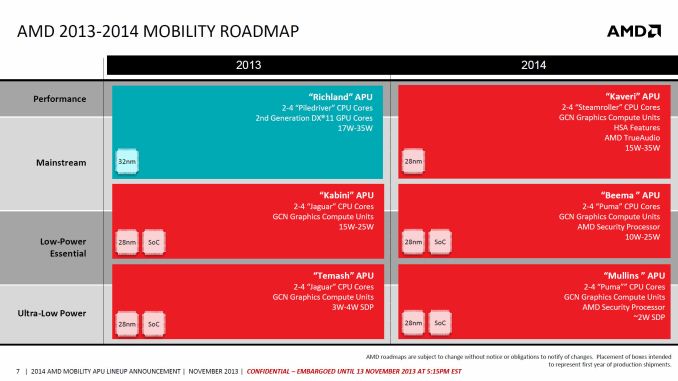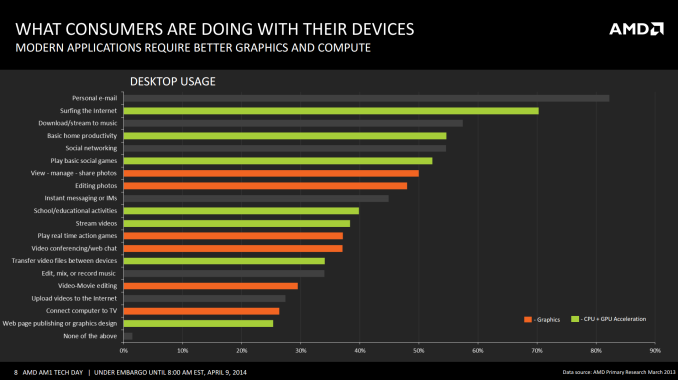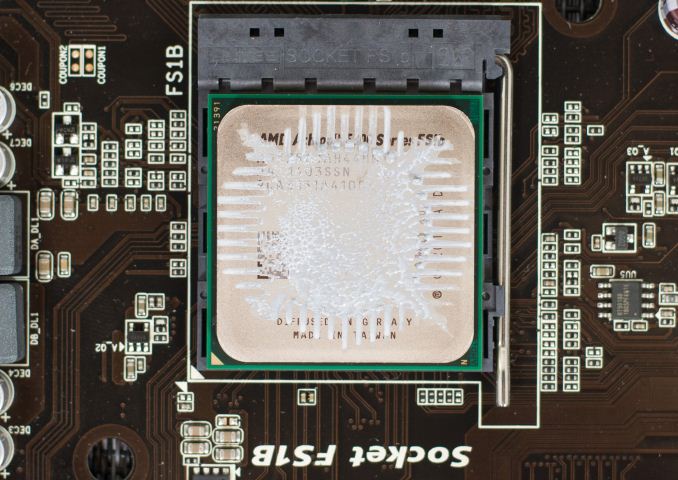The Desktop Kabini Review Part 1: AMD Athlon 5350 (AM1) Tested
by Ian Cutress on April 9, 2014 8:00 AM ESTFinal Words
As mentioned in our test setup, the benchmark results in this preliminary article are only a small fraction of our normal coverage. Due to other commitments we were unable to run every test on all comparison systems, but we have the other Athlon and Sempron APUs as well as comparable Intel counterparts coming in for review.
The poignant place to start with the final analysis is AMD’s claim of ‘Quad Core for Less’. In this statement alone, they are not wrong. Intel cannot provide a socketed quad core processor for less than $36 (Sempron 3850). The cheapest all-in-one desktop quad-core system from Intel equips the Celeron J1900 onto a motherboard for $92, which is exactly where AMD sit with the top-end Kabini based Athlon 5350 with a motherboard. One of the issues to consider at this point however is that Intel offers several dual core options (non-Atom) around this $40-$60 price point, and in many cases the IPC and CPU speed advantage of these cores is greater than that provided by Kabini, particularly in single threaded applications. The only downsides to this solution are the power consumption is higher, and the motherboards are more expensive. For a competitive socketed Intel dual core, a motherboard plus CPU can be in the region of $110-$120 at 35W-55W.
The big upside and selling point from the AM1 Kabini platform should be upgradeability. If a user buys an AM1 platform now, they should be able to upgrade it in the future. While AMD has not yet confirmed if Beema is coming to the socketed platform, the roadmaps suggest that the laptop sockets are remaining consistent from Kabini to Beema. This should imply that if Beema gets a socketed version, it should also remain based on AM1/FS1b.
If we compare single threaded performance between Kabini and our J1800 test system, the benchmarks are almost even between the two, particularly when it comes to synthetics such as Cinebench, but falls behind on emulation such as the Dolphin Benchmark and 3DPM. The integrated graphics of the Kabini pull ahead when it comes to gaming, despite the single channel memory interface.
|
AMD Athlon 5350 vs. Intel Celeron J1800 Single Threaded |
||
| Athlon 5350 | Celeron J1800 | |
| Cinebench R10 | 1967 | 1917 |
| Cinebench R11.5 | 0.51 | 0.49 |
| Dolphin Benchmark | 40.4 | 38.02 |
| 3DPM | 53.29 | 69.20 |
When placing Kabini against any Intel Ivy Bridge socketed processor, the increased IPC and frequency pushes the system above the Kabini, in exchange for more power and a more expensive system overall. If we compare the Kabini single-threaded results to those of the Celeron G465, a Sandy Bridge based single core CPU at 1.9 GHz, the Celeron does pull ahead on the majority, but fails miserably in the graphical benchmark suite.
|
AMD Athlon 5350 vs. Intel Celeron G465 Single Threaded |
||
| Athlon 5350 | Celeron G465 | |
| Cinebench R10 | 1967 | 2975 |
| Cinebench R11.5 | 0.51 | 0.73 |
| Dolphin Benchmark | 40.4 | 38.8 |
| 3DPM | 53.29 | 59.98 |
Does it seem particularly odd that a modern Kabini architecture at 2 GHz cannot keep up with a 3 year old Sandy Bridge processor at 1.9 GHz at our simple benchmarks? AMD is leveraging on the fact that much of what we do on a computer as a casual user can leverage the fixed function units of the graphics center of the APU:
AMD’s key in all of this is leveraging the GPU. For non-GPU intensive tasks, on paper, the J1900 for $92 and 10W TDP would seem to be the choice if upgradability is not a concern. The remit of AM1 and Kabini could be extended if motherboard manufacturers decided to use those extra PCIe lanes. Consider an AM1 with controllers to make a nice routing system (4x NIC) or something based around storage (SATA controllers and hubs). But because Kabini is also a cost play for AMD at the low-end desktop segment, margins are going to be ultra-tight for motherboard manufacturers and I do not imagine that as much effort will be put into making innovative products as the rest of their product range on other sockets.
In order for the upgradability angle to work, AMD need to keep the sockets around for at least two generations. AM1 comes late in Kabini’s life cycle, given that Beema on the mobile side is due out later in 2014. It would make sense for AMD to release Beema desktop parts, but the big question there is when. AMD could launch new processors on day 1 of Beema, or further into the life cycle. I would imagine that depends on what the competition does. AMD does have that advantage of having an upgradeable platform before Intel; however Intel may see the market differently. It is a hard one to judge.
Stay tuned for our full benchmark suite on the other AMD Kabini APUs.














126 Comments
View All Comments
5thaccount - Thursday, April 10, 2014 - link
100% agree. Any Core 2 or newer based system with plenty of memory and an SSD will work fine for most users out there (the ones that use office, browse the web, and watch youtube)... and for quite a few years to come. Heck, I'm still using my E5200 daily after 6 years. Works perfect! Even looking at these benchmarks, the new Kabini is slower than a Core 2 Duo E8400. Which, oddly enough, can be picked up for under $20 on eBay... now that's a deal!jonathanharrison - Thursday, April 10, 2014 - link
I got a whole Vostro 200 system used with 20" widescreen LCD, 4GB DDR2 RAM (667), Core 2 Duo E6550 from a dude on Craigslist for a mere $45. Wife had gone to the Mac side and wanted the system out of the house ASAP. That's one way to do it - all but GIVE it away :)On-board intel graphics kinda don't cut it for gaming, so... when I could, I added a Sapphire Radeon HD 7770 GHz Edition 1GB video card ($109) and a 550W ThermalTake power supply ($40) into it and plugged it also into my other 20" monitor with a HDMI-DVI cable ($8) for a nice dual display... may go triple-head when I can afford to... wireless mouse/keyboard set ($30), Logitech gamepad F310, ($25)... and I've got a pretty nice light/older (DX9/10) gaming system for less than $220 of new purchases...
trueserve - Friday, April 18, 2014 - link
"A CPU only holds value if it is overclockable and the motherboard supports overclocking the processor."wat.
mikato - Friday, April 11, 2014 - link
Yeah, I had a Core 2 Duo E7300 in my wife's gaming system, and then when the latest COD came out with higher requirements, I bought a nice GTX 760 video card to put in there (with bigger PSU), and a better Core 2 Duo E8500 on ebay to go with it. Unfortunately the CPU was still really limiting things though, even after overclocking as much as I could, so in the end I had to build a new system around the video card... got an i5 4670K. But your point is valid. The system was used for HTPC tasks, XBMC, Skype, etc as well and the Core 2 Duos performed just great in everything besides the latest COD game, which is apparently a resource hog.phoenix_rizzen - Wednesday, April 9, 2014 - link
Wouldn't the PCIe x4 slot be the bigger bottleneck?nathanddrews - Wednesday, April 9, 2014 - link
PCIe 3.0 x2 = PCIe 2.0 x4 = PCIe 1.0 x8 = 2GB/sechttp://www.anandtech.com/show/5458/the-radeon-hd-7...
Even with just a PCIe 2.0 x4 electrical, it would still be massively CPU-bound. I wonder if any other manufacturers will bother to do a fully enabled x16 slot?
extide - Thursday, April 10, 2014 - link
They can't, there simply arent enough lanes on the CPU. If they ditched the NIC and uses every single lane for graphics, you could have x8.nathanddrews - Thursday, April 10, 2014 - link
Ah yes, you are correct.jonathanharrison - Thursday, April 10, 2014 - link
Hey, I resemble that. I've got a Radeon HD 7770 GHz being underfed by a Core 2 Duo E6550. Used system bought for cheap then added the video card, purchased new. I guess the 7750 would have been more than enough, but hey, the 7770 was a steal at $109. How's that for a CPU/GPU imbalance? Hey... at least it's in the right direction for gaming. I'd rather be CPU-limited than GPU-limited any day. I can still run 99% of the games out there, and do so with rather high settings and at least 4X AA most of the time. Maybe not 60fps in all games, but in a lot of them, especially the older ones, and getting 30fps or close in some of the newest (like MKKE).etamin - Wednesday, April 9, 2014 - link
In the "key points" on the first page, you listed two SATA 3gbps ports, but the Gigabyte comes with 2x SATA III. The block diagram shows two "SATA 2/3". In any case, two SATA ports is extremely restrictive. If mSATA and/or secondary SATA controllers can be had for the same $35, this would make for a terrific micro media server.